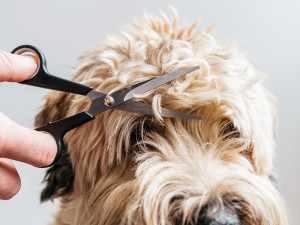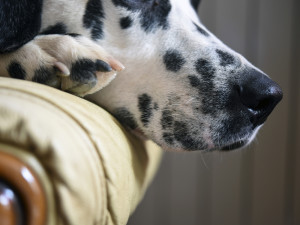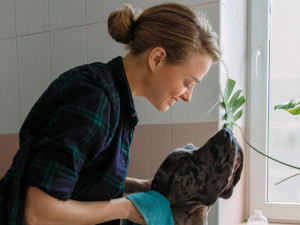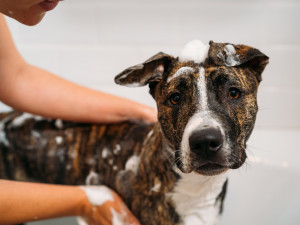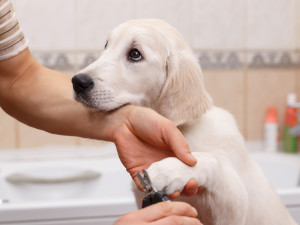How to Trim Your Dog’s Nails
Five simple steps for trimming your dog’s nails at home.
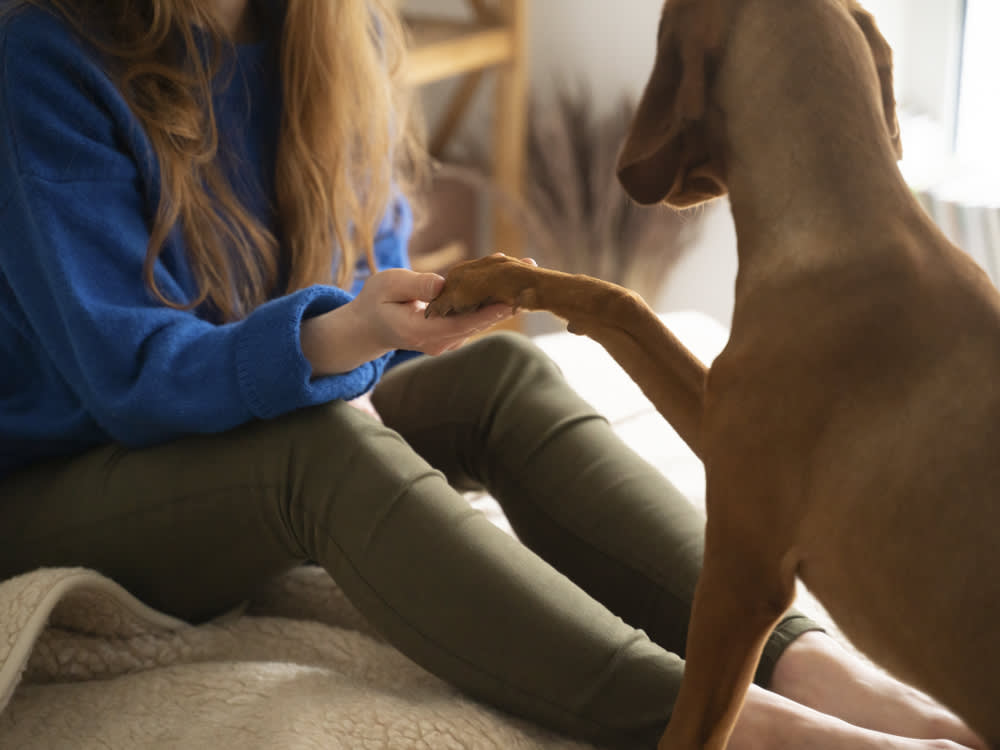
share article

Your pet wants you to read our newsletter. (Then give them a treat.)
When to Trim opens in a new tab Toolsopens in a new tab How To Make Your Dog More Comfortableopens in a new tab Trimming Tipsopens in a new tab
It might sound intimidating, but speaking as someone who worked as a dog groomer for about a year, trust me: It’s possible to cut your dog’s nails at home. All it takes is the right tools and a little (OK, a lot) of patience. It also helps to keep your dog occupied with treatsopens in a new tab or their favorite chew toyopens in a new tab, and to be sure to take lots of breaks because this aspect of grooming can be anxiety-inducingopens in a new tab for many dogs. Below, learn everything you need to know about how to make the process as pain-free (and stress-free) as possible.
When to trim your dog’s nails
There is no simple answer to how often you should trim a dog’s nails because each dog wears down their nails differently. Some dogs wear their nails down naturallyopens in a new tab to an ideal length because of walks, but others might need trims once every two months.
One way to determine if your dog needs a pedicure is to manually extend the toes and assess the length of the nails in relation to the bottom of the foot. To do this, place your thumb on top of your dog’s foot and your other fingers on the large pad on the underside of the foot. Gently squeeze your fingers together, which will cause the toes to extend. With the toes in this position, check to see if the tips of the toenails are level with or go beyond the underside of the foot. The former can be left alone, while the latter need to be trimmed. To be certain about whether or not your dog’s nails are too long, consult with your veterinarian, vet tech, or groomer.
“Some dogs have clear nails, which allows you to easily tell how far the tip of the nail extends beyond the quick — that pink- to red-colored, blood-filled cavity that runs down the center of the toenail. If the nail extends well beyond the quick, it’s time for a pedicure,” veterinarian Dr. Nancy Kay says. Be aware that dogs with chronically overgrown nails may also develop lengthy quicks, so trim small amounts but more often. “It’s easy to hit the quick, and that can be painful for your dog. Also, a nicked quick bleeds, not enough to be harmful to your dog, but enough to sure as heck be harmful to your carpeting,” she adds.
It’s best to perform nail trimming only as needed and to know how to clip dog nails that are too long safely. To get your dog comfortable with being handled, perform regular at-home physical health examinationsopens in a new tab. This way, they’ll feel more relaxed when you trim their nails.
The tools you’ll need to trim your dog’s nails
You don’t need a ton of toolsopens in a new tab to clip your dog’s nails at home. Before you start, gather up the following:
High-quality pair of dog nail trimmers
Dremel nail grinder
Styptic powder (such as Kwik-Stop) to stop bleeding if you nick the quick, which is the blood vessel that supplies blood to the claw
How to safely trim your dog’s nails
Now that you have the supplies, it’s time to get trimming. Unfortunately, most dogs are initially uncomfortable with having their nails trimmed, which is why it’s important to practice and to learn how to trim your dog’s nails when they hate it. Training is key for cutting dog nails at home — if you have a young dog, get started early. Some may happily sit in your lap, but even with training, other dogs may require some form of restraint.
1. Find a comfortable position
The right position can enable an easy way to trim dog nails — or easier, at least. You may want to start by sitting on the floor with your dog on your lap. You can also hold them on a table or have someone help hold them. Position your body opposite the nail you are trimming.
2. Keep your dog calm
Gently pat and massage your dog to help them relax and strive to find ways to trim your dog’s nails that are as non-stressful as possible. Make trimming time fun and not a struggle — high-value treatsopens in a new tab help, as does a cheerful, calm presence.
3. Assess your dog’s nails
Hold your dog’s paw firmly and push on the pad to extend the nails, then locate where the quick ends. With clear or light dog nails, it’s easy to see the pink color that indicates where the quick is. But with black or dark nails, you’ll need to cut in several small increments to reduce the chance of cutting into it and making your dog bleed. Learn how to know where to trim black dog nails, and if you don’t easily see the quick or aren’t confident, don’t hesitate to enlist the services of a seasoned dog groomer.
4. Clip the nails, avoiding the quick
A scissors-type nail trimmer is the grooming productopens in a new tab best used to trim dog nails that are long enough to curl. With the cutting end of the nail clipper toward the end of the nail, trim below the quick on a 45-degree angle. Make several small snips with the clippers instead of one large cut.
For dogs with dark nails: As you cut off small pieces of the nail, look at the cut edge. As you cut the nail deeper, you will begin to see a homogenous gray-to-pink oval appear at the top of the cut surface. Stop cutting the nail at this point, as additional cutting will sever the quick.
Your goal is to cut the claw within approximately two millimeters of the quick. Ultimately, nails should be trimmed so that when dogs step down, their nails don’t touch the floor. If you accidentally cut into the quick, the claw will bleed and your dog will experience some pain. Wipe off the blood and apply Kwik-Stop or styptic powder to stop the bleeding. And don’t worry, these cuts usually aren’t serious and will heal in a short time. Even without any treatment, the nail should stop bleeding in about five minutes or less.
5. Take breaks — and reward your dog with treats
Go slowly and take breaks between each paw, especially if your dog is new to at-home nail trimming. Consider rewarding them with treats after each clip. Over time, you can build up to several cuts or paws between treats. Give your dog (and yourself) time to relax and build confidence by taking breaks as needed. Try to turn nail trimming into a relaxing and fun activity, like a puppy spa dayopens in a new tab.
How to get your dog comfortable with being handled
Before you worry about how to cut your dog’s nails at home, you should focus on getting them more comfortable with being handled and touched. Start handling your puppy as soon as possible, so they feel more comfortable with having their paws and other parts of their body touched and examined. This can help for nail clipping, as well as vet visits and groomingopens in a new tab.
Always be gentle when handling your dog.
Make sure to handle your puppy when they are calm, not playful or energetic.
Hold your puppy on your lap and gently touch their feet, examining the paw pads and spreading the toes.
Perform these handling exercises regularly so your puppy feels comfortable with them.
A few nail-trimming things to keep in mind
When learning how to cut dog nails short safely, it’s important to take your time and be patient — with your dog and yourself. Follow these tips as you start trimming your dog’s nails:
In some cases, if the nails are brittle, cutting may splinter the nailopens in a new tab. In these cases, file the nail in a sweeping motion starting from the back of the nail, following the curve to the tip.
Trim a small amount on a regular basis instead of removing large portions less regularly.
Invest in a good pair of nail trimmers in an appropriate size for your dog. They can last a lifetime.
“There are dogs who, no matter what, struggle so much that four people are needed to accomplish the nail trims — three to restrain the wriggling beast and one to trim the nails (and these are dogs who are often perfectly mannered in every other situation). In such cases, one has to question whether or not it’s really worth it,” Dr. Kay says. Talk with your vet about how to make nail trims less stressful and more successful.
What happens if you fail to trim your dog’s nails enough?
Unhealthy nails are more than a cosmetic issue — they can cause pain and, in some cases, injury that can impact your dog’s life and comfort. Regular nail trimming causes the quick to recede from the end of the dog’s nail, which leads to easier maintenance and a healthier dog. When a dog’s nails grow too long, they can result in a splayed foot, which can lead to difficult walking and even injured tendons.
How do I trim a dew claw?
Dew claws, also known as “puppy thumbs,” are the claws on the side of the paws. Some dogs only have dew claws on their front feet, while others don’t have them at all. It’s very important to keep your dog’s dew claws trimmed because they can grow into the skin and cause issues if not properly maintained.
Fortunately, dew claws are easier to trim than the other nails. To check your dog’s dew claw, run your finger under the nail. If the nail catches on your finger, it’s time for a trim. Just as with the other nails, look for the quick in the dew claw to avoid cutting it and trim the nail only until your finger easily slides off without catching.
What should you do if you accidentally cut the quick?
If you accidentally cut the quick of your dog’s nail, don’t panic! It’s very easy to do and happens to every dog parent at some point. That’s why it’s important to know first aid treatment for trimming the nail. Your dog’s nail will bleed if you clip too short and catch the quick, the blood vessel in the claw. Make sure to have styptic powder on hand before trimming your dog’s nails, so you can use it to help the blood clot more quickly. If the bleeding doesn’t slow down or stop within an hour, take your dog to the vet.
How much does professional nail trimming for dogs cost?
The average cost to trim dog nails ranges from $10 to $25 but can be more depending on your location and whether you go to a veterinarian or a professional groomer. If you’re unsure about trimming your dog’s nails yourself, contact local groomers or ask your vet for pricing.
FAQs (People also ask):
Are there any alternatives to nail trimming?
If you’re wondering how to clip dog nails without clippers, you can use a grinder to maintain your dog’s nails. As its name implies, a grinder grinds down the nail instead of cutting off pieces, allowing for a more controlled, gradual trim.
What signs indicate it’s time to trim my dog’s nails?
There are several signs that your dog is due for a pedicure:
Their nails look long and start to curve.
You hear your dog’s nails clicking on the floor when they walk.
Your dog begins to scratch you or your furniture.
Your dog is licking excessively or walking awkwardly.
How can I make the experience less stressful for my dog?
The best way to make nail trimming less stressful for your dog is to offer plenty of treatsopens in a new tab and praise throughout the process. Praise them and offer a tasty treat after every snip. You may even want to use peanut butter or another favorite snack to keep your pup occupied while you trim their nails.
How do you use a Dremel nail grinder?
With a nail grinder, you should only grind a small part of your dog’s nail at a time. Make sure to support the toe firmly but gently and grind across the bottom of the nail and then move in from the tip, smoothing rough edges as you go. Just as with nail clippers, be sure to keep your dog comfortable throughout the process and pay attention to any distress or discomfort they seem to feel. If your dog has long fur, keep their hair away from the grinder so it doesn’t get caught.
References

Savannah Admire
Savannah Admire is a writer, editor, and pet parent to two dogs and a cat. When she’s not writing, you can find her reading, playing Animal Crossing, or being an obnoxious nerd about her favorite movies and TV shows. She lives in Maryland, where she constantly debates whether or not to get a third dog.
Related articles
![Three eco-friendly pet grooming products displayed in a collage.]() opens in a new tab
opens in a new tab11 Eco-Friendly Pet Grooming Products
Package-free brushes, plant-based wipes, certified-organic shampoos, and more.
![A white dog getting a bath with suds and bubbles everywhere.]() opens in a new tab
opens in a new tabWhere to Groom Your Dog Outside of Your Tiny NYC Bathroom
A new East Village self-serve grooming salon features high-tech automated wash pods that are designed to get your dog in and out of the bath without drama.
![Smiling woman wiping ears of dog]() opens in a new tab
opens in a new tabShould You Clean Your Dog’s Ears at Home?
Heed all those cautionary tales about Q-tips.
![A dog getting a bath]() opens in a new tab
opens in a new tabHow Often Should You Wash Your Dog?
“If your dog is stinky or looks dirty, wash ’em!” Plus more pro tips from LA dog groomer Jess Rona.
![The-Wildest_Editorial_Puppy-grooming-tips_Hero_1000x750_v01.jpg]() opens in a new tab
opens in a new tabPuppy Grooming 101: Tips for Grooming Your New Puppy
Celebrity dog groomer Jess Rona’s puppy grooming pro tips.
![A wheaten terrier getting a haircut to remove the hair from over his eyes]() opens in a new tab
opens in a new tab11 of the Best Dog Grooming Products
Tools to keep your pet looking so fresh and so clean, from bamboo hair brushes to biodegradable wipes.

